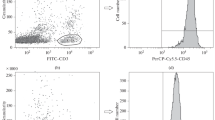Abstract
The expression of the ectoenzymeγ-glutamyl transpeptidase (EC2.3.2.2.,γGT) was investigated by flow cytometry on populations of peripheral blood mononuclear cells (PBMC) from healthy subjects and patients suffering from several types of leukemia before and under chemotherapy. In unstimulated PBMC, 28% of these cells were found to beγGT positive. The highest expression was measured on monocytes (CD14/γGT+ cells: 60%). Within the subsets of T lymphocytes (CD3/γGT+ cells: 18%) we saw no clear differences between CD4+ and CD8+ cells. B lymphocytes, NK cells, and activated cells showed low expressions (up to 10%). Treatment of PBMC with mitogens, α-IFN, IL-2, and GM-CSF did not affect the enzyme expression on normal mononuclear cells (MNC). However, a rapid increase of yGT+ cells was found in the presence of glutathione (GSH) and n-acetyl cysteine (nAC), particularly on monocytes, B cells, and NK cells. Comparing 40 healthy subjects and untreated patients suffering from leukemias, a significantly higher expression ofγGT+ cells in the total MNC populations (B-CLL: 57%, CML: 62%γGT+ cells) was observed in B-chronic lymphocytic leukemia (B-CLL) and chronic myelogenous leukemia (CML), whereas other leukemias did not show clear differences. Most interestingly, theγGT expression was diminished in all populations of CML cells after 5 h of incubation in the presence of 10 units/ml IFN-α. These data suggest a possible protective role ofγGT in MNC and a regulatory function of this enzyme in the development of CML.
Similar content being viewed by others
References
Bulle F, Mattei M (1987) Assignment of the human gammaglutamyl transferase gene to the long arm of chromosome 22. Hum Genet 76:283–286
Curthoys NP, Hughey RP (1979) Characterization and physiological function of rat renal gamma-glutamyl transpeptidase. Enzyme 24:383–403
Frey A, Gassen HG (1991) Pericytes of the brain microvasculature express gamma-glutamyl transpeptidase. Eur J Biochem 202:421–429
Gmünder H, Dröge W (1991) Differential effects of glutathione depletion on T cell subsets. Cell Immunol 138:229–237
Grisk O, Ansorge S (1993) The activity of gamma-glutamyl transpeptidase in populations of mononuclear cells from human peripheral blood. Biol Chem Hoppe Seyler 374:287–290
Hanigan MH, Pitot HC (1985) Gamma-glutamyl transpeptidase-its role in hepatocarcinogenesis. Carcinogenesis 6:165–172
Hanigan MH, Ricketts WA (1993) Extracellular glutathione is a source of cysteine for cells that express gamma-glutamyl transpeptidase. Biochemistry 32:6302–6306
Heisterkamp N, Groffen J (1988) Duplication of the bcr and gamma-glutamyl transpeptidase genes. Nucleic Acids Res 16:8046–8056
Kloke O, Niederle N, Qin JY, Wandl U, Moritz T, Nagel-Hiemke M, Hawig I, Opalka B, Seeber S, Becher R (1993) Impact of interferon alpha-induced cytogenetic improvement on survival in chronic myelogenous leukaemia. Br J Haematol 83:399–403
Miller AM, Weiner RS, Ziboh VA (1986) Evidence for the role of leukotrienes C4 and D4 as essential intermediates in CSF-stimulated human myeloid colony formation. Exp Hematol 14:760–765
Miller AM, Sandier E, Kobb SM, Eastgate J, Zucali J (1993) Hematopoietic growth factor induction of gamma-glutamyl transferase in the KG-1 myeloid cell line. Exp Hematol 21:9–15
Smyth MJ (1991) Glutathione modulates activation-dependent proliferation of human peripheral blood lymphocyte populations without regulating their activated function. J Immunol 146:1921–1927
Staal FJ, Roederer M, Herzenberg LA (1990) Intracellular thiols regulate activation of nuclear factor kappa b and transcription of human immunodeficiency virus. Proc Natl Acad Sci USA 87:9943–9947
Stenius U, Högberg J (1988) Gamma-glutamyl transpeptidaseconferred resistance to hydroquinone-induced GSH depletion and toxicity in isolated hepatocytes. Carcinogenesis 9:1223–1227
Tate SS, Meister A (1985) Gamma-glutamyl transpeptidase from kidney. Methods Enzymol 113:400–419
Tate SS, Khadse V, Wellner D (1988) Renal gamma-glutamyl transpeptidases: structural and immunological studies. Arch Biochem Biophys 262:397–408
Vanderlaan M, Phares W (1981) Gamma-glutamyl transpeptidase: a tumor cell marker with a pharmacological function. Histochem J 13:865–877
Author information
Authors and Affiliations
Rights and permissions
About this article
Cite this article
Täger, M., Ittenson, A., Franke, A. et al. γ-Glutamyl transpeptidase-cellular expression in populations of normal human mononuclear cells and patients suffering from leukemias. Ann Hematol 70, 237–242 (1995). https://doi.org/10.1007/BF01784042
Received:
Accepted:
Issue Date:
DOI: https://doi.org/10.1007/BF01784042




